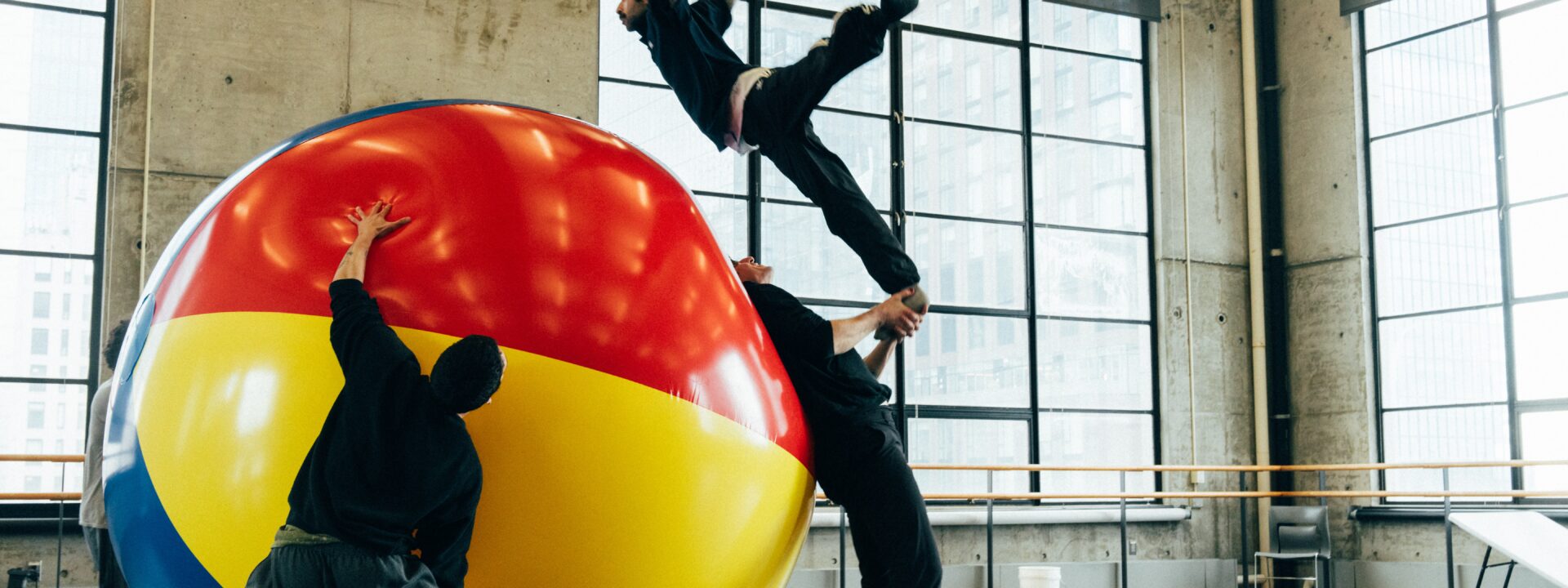Creating art is already a struggle for an independent choreographer—competing for grants, rehearsal space, and attention in a fragmented arts scene. But throw in raising a young child and caring for a sick parent, and the weight of everyday life becomes overwhelming.
This is the foundation of SISSY, a radiant new dance-theater piece by Celia Rowlson-Hall, premiering this weekend at New York’s Baryshnikov Arts Center with a cast including Marisa Tomei and Lucas Hedges. In this inventive retelling, Sisyphus isn’t trapped in the underworld but stuck at a rundown artist residency in the Hudson Valley, where a relentless director (Zoë Winters) and her six dancers prepare for their final showcase after a two-week workshop. The audience—both the fictional one upstate and the real one in Manhattan—soon finds themselves in a world where oversized beach balls and paint buckets become tools for physical exploration, and the bittersweet absurdity of real life seeps in.
Celia Rowlson-Hall
Photo: Quinn Wharton
“I’ve always had a layer of separation between me and my work, even though it’s deeply personal,” says Rowlson-Hall, who has built a career telling stories through movement. “With this piece, that barrier is gone.” SISSY marks her return to the stage after nearly two decades as a filmmaker and screen choreographer. It’s also her first creative project since the birth of her son, Romeo, now two, whom she shares with her wife, director (and SISSY dramaturg) Mia Lidofsky.
The piece began taking shape during a 2023 residency at Baryshnikov Arts Center. The couple, staying in a West Village apartment at the time, would walk up the High Line to the studio each day with six-month-old Romeo in tow. Meanwhile, Rowlson-Hall was grappling with her father’s declining health—a devoted public school teacher, cross-country coach, and Christian Scientist who had largely avoided medical care. As he moved between hospitals and care facilities in Virginia—a “losing uphill battle,” she says—plans for a full-length version of SISSY were put on hold. But the myth of Sisyphus stayed with her. She read Robert Macfarlane’s Underland, about the ancient world beneath our feet, and another book that described grief as “like pushing through rock.”
The cast of SISSY
Photo: Quinn Wharton
True to Rowlson-Hall’s playful style, Sisyphus’ boulder in SISSY becomes a bright beach ball—something the performers wrestle with, slide over, and toss into the air, carefully avoiding the studio’s overhead lights during rehearsal. Stones appear in other ways too, like in an onstage improvisation where Winters’ character asks, “Are you a pebble in a shoe? Or under a bare cheek on an Italian beach?”
The play-within-a-play structure blends six dancers (led by the mesmerizing Ida Saki) and three actors, blurring the lines between them. Tomei, playing an archaeologist, brings a lively physicality—even a full split—to the role, embodying Rowlson-Hall’s vision. “I love her artistic voice; she speaks a language I understand,” says Tomei. “In my soul, I’m a dancer.” Hedges, as a blue-collar quarry worker, finds his tough exterior softening by the end. For him, SISSY is a dreamlike space he “wants to get lost in.” He adds, “Celia has brought her subconscious to all of us, and we’re just walking through it.”
Lucas Hedges
Photo: Quinn Wharton
That mix of mythic imagery and raw human emotion is a signature of Rowlson-Hall’s work. It’s…In 2015’s MA, her feature-length debut, she followed a virgin mother crossing the desert toward Las Vegas. Her short film for the Miu Miu Women’s Tales series filled a Cold War-era bunker with a group of eccentric performers. Working as a choreographer for music videos (MGMT, Bleachers, Alicia Keys) and films (After Yang, Vox Lux) has sharpened her adaptability on set. But she credits motherhood with unlocking a new creative flexibility. “Sometimes when you set something in motion, you have to let it guide you instead of trying to control it too tightly,” she says.
This idea came up during the first lunch break of the SISSY residency in 2023, when she told Rowlson-Hall—by then a friend and collaborator—that she was newly pregnant. “The whole story shifted for her,” Saki explains, describing how the choreographer wove the news into the central solo, a complex exploration of anticipation and innocence. In the dance, Saki wears pants with an attached belly, but the emotional vulnerability is what truly resonates. “If you’re not fully immersed in the storytelling and emotion in the moment, the performance falls flat,” she says.
Ida Saki
Photo: Quinn Wharton
There’s another uncredited performer who has, in a way, been part of SISSY from the start—Saki’s one-year-old son, Enzo, who occasionally appears onstage in Winters’s arms, a babbling reminder of the balancing act her character faces. Winters recalls her initial reaction to learning she’d be holding a real baby during the show. (“Like, an actual baby?” she asked. “Yes, an actual baby,” Rowlson-Hall replied.)
Incorporating this unpredictable element reflects Rowlson-Hall’s embrace of life’s beauty and messiness. Enzo’s spontaneous sounds contrast with a voicemail from Rowlson-Hall’s late father, played overhead. The blur between reality and fiction lends the performances a striking clarity. Winters, who lost her own father a decade ago while working with Rowlson-Hall on another project, speaks of their shared language around grief. “Grief is unpredictable—it sneaks up in unexpected ways,” she says, yet it often “sits right beside humor.”
That duality defines SISSY, where folding tables become slides and air-traffic wands light the path. “There’s so much imagination, magic, and strangeness,” Winters says. “Moments you might not fully grasp intellectually but can feel deeply.” One standout is a duet where Aliza Russell’s every step lands in Jacob Warren’s hands, a poetic transfer of weight. It echoes what Rowlson-Hall said after rehearsal, watching Winters step into the director’s role: “After seeing her take charge, I realized—it’s her show now. She carries it.”
SISSY runs through April 26 at Baryshnikov Arts Center.
